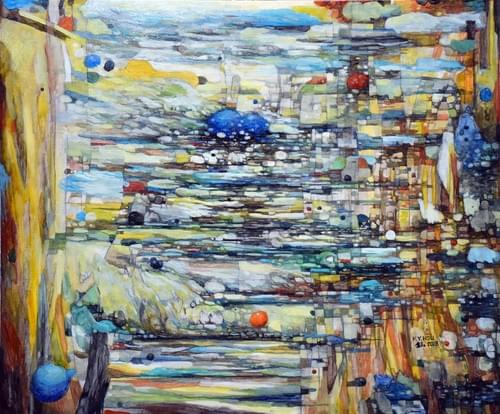
山水系列之摺景 1 限量數位典藏版 No.1~15 / 15
NT$3,200
那不再是寫實的山水,
而是記憶與時間摺疊後留下的紋理與裂縫。
《山水系列之摺景 1》是藝術家 Kuo Yu HSU 許國鈺對於風景意象的轉化與凝視。
作品中空間與色彩層層堆疊,如同潛意識中記憶交錯、情感交疊的軌跡。
此次特別推出數位典藏版本,全球限量 15 份,
附藝術圖卡與正式授權書,邀請您收藏一幅靜謐而深邃的心靈地景。
💾 商品內容:
高解析數位圖檔(JPG,4143 x 3431 px,300dpi)
授權列印最大尺寸:約 35.1 × 29.1 cm對應紙張尺寸約略為A3
附藝術圖卡一張(作品介紹+限量編號)
附數位授權書(含限量編號與藝術家簽名)
限量15份。每份皆附限量編號(如 KHSU-SS01-01/15),永久授權單次列印收藏。
建議採用5760dpi高解析度,250g/m²以上的彩色相片紙列印,高品質彩色印表機列印,即可呈現最佳細節層次。
切勿使用一般的彩色影印,效果極差。
向左滑動即可查看它的數位簽名
🔖 收藏這件作品,適合你如果:
你嚮往穿越風景與記憶之間的抽象旅程
喜歡結合詩性與秩序的藝術語言
想收藏經藝術家親簽認證的限量數位創作
下單成功後會看到下載鏈接(鏈接有效期 72 小時),同時會收到一封附加下載鏈接的確認郵件。
下載完成後,我們將以電子郵件寄送藝術圖卡與授權書。

原作:山水系列之摺景 1 60.5x72.5cm 布面油畫 2018年 (已獲收藏)
《摺景1》創作理念
《摺景1》是一件圍繞「空間的摺疊性」與「記憶的層次性」進行視覺探索的作品。它試圖回應的是:當代人在經歷時間斷裂與知覺分層的狀態下,如何重新觀看並建構「風景」。與其說這是一幅再現自然的山水畫作,不如說它是對內在地景的一種抽象建構,一場關於知覺與記憶的視覺實驗。
在傳統美學中,「風景」常被視為某種客觀、靜態的自然映照,是觀看與被觀看的二元構造;而在《摺景1》中,風景成為心理場域的投射,成為意識與潛意識交錯下的生成圖像。畫面中的摺痕與堆疊,並非來自物理現實的摺紙技術或摺景視角,而是一種象徵性圖式,代表時間、經驗與感知的扭曲與壓縮。這樣的處理方式亦可視為對當代圖像空間(image-space)流動性的回應,使風景成為可被折疊、展開、重新組構的思維結構。
我透過多層次的色彩層疊與筆觸流動,營造出一種既具結構又不穩定的畫面質地。每一道摺痕,都是一次「視覺事件」的介入;每一層褶皺,都像是一段記憶被重新壓縮的結果。這種非線性的空間安排,破除了單點透視的觀看慣性,導引觀者進入一種模糊的、介於記憶與幻象之間的知覺狀態。換言之,這不僅是觀看風景,更是經歷風景——以心理的方式,以感性的深度。
在概念層面上,《摺景1》亦受到東方哲學中「變化」、「空無」與「有機秩序」觀點的啟發。摺痕作為邊界與連結的雙重意象,呈現出一種動態的對應關係:實與虛、現實與想像、時間的累積與遺忘的裂縫。這使得作品不僅僅是視覺的對象,更是一種「知覺的地景」(landscape of perception),一個由經驗與想像所共構的心理場。
此外,「摺」的語意亦可延伸至德勒茲(Gilles Deleuze)在其著作《褶子》中對於褶皺(the fold)作為哲學結構的討論。他主張褶皺不只是物質的形變,更是一種連接內在與外在、表層與深層的動態模式。在這樣的脈絡下,《摺景1》的畫面摺疊便不再只是形式語言,而是一次感知邊界的擴張,是個體在複數世界中不斷定位自身的過程。
總結而言,《摺景1》是我對風景這一類型命題的再思與重構。它拒絕單一視角與穩定敘事,取而代之的是一種開放、可變、內省的觀看方式。觀者在其中不會找到清晰的地標或方向,而是被邀請進入一個由摺疊構成的感知迷宮——一個無法命名、卻深刻回響於心的風景之地。這是對風景的摺疊,也是一種觀看自身的摺景。
Artist Statement for Folded Scenery 1
Folded Scenery 1 is a visual exploration centered on the notions of spatial folding and the layered nature of memory. It seeks to respond to a central question: how can we re-envision and reconstruct “landscape” in an age shaped by perceptual fragmentation and temporal discontinuity? Rather than portraying a physical terrain, this work constructs a psychological landscape—an abstract formation shaped by perception, memory, and affect. It is, in essence, a visual inquiry into how we experience and internalize the world.
In classical aesthetics, “landscape” is often perceived as an objective and static mirror of nature, shaped by a binary relationship between observer and observed. In Folded Scenery 1, I challenge this model by treating landscape as a mutable, inner field—one that emerges from the entanglement of consciousness and subconscious traces. The folds and overlaps in the composition are not derived from physical structures, but operate symbolically: they embody the distortion, compression, and reconstruction of lived time, psychological experience, and perceptual residue. In this way, the piece responds to the fluidity of image-space in contemporary visual culture, positioning landscape as a conceptual structure—one that can be folded, layered, and reassembled.
Through multi-layered applications of color and fluid brushwork, I aim to build a surface that is both constructed and unstable. Each crease functions as a “visual event,” a moment of interruption and redirection. Every fold suggests a compressed memory fragment, inviting the viewer into a non-linear spatial encounter. Rather than offering a clear focal point, the painting evokes a shifting, dream-like perceptual state—one that resists traditional one-point perspective and linear temporality. It is not a scene to be viewed from afar, but a landscape to be felt and traversed from within.
Conceptually, the work draws from Eastern philosophies that emphasize impermanence, emptiness, and organic transformation. The fold serves as both boundary and bridge—an image of duality that embodies presence and absence, reality and imagination, accumulation and rupture. Thus, the painting becomes not merely a visual composition, but a “landscape of perception”—a site formed through the interplay of memory and imagination, of forgetting and emergence.
The idea of folding also resonates with Gilles Deleuze’s philosophical writings in The Fold, where the fold is described not merely as a formal element, but as a dynamic system connecting the interior and the exterior, the visible and the invisible. In this context, the folded forms in Folded Scenery 1 are not only aesthetic choices but also a conceptual strategy—expanding the boundaries of perception and inviting viewers to engage with the complexities of lived experience.
In sum, Folded Scenery 1 is a reconfiguration of the landscape genre. It resists singular viewpoints and stable narratives, offering instead an open, shifting, and introspective space. The viewer is not provided with landmarks or clear direction, but is invited into a perceptual labyrinth—a folded terrain that defies naming, yet resonates deeply in the subconscious. This is a landscape folded inward, and a landscape through which one may also come to see oneself anew.



